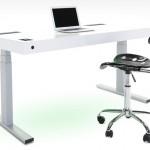 I’ve written previously about the important role ones work environment plays in creating a social business, with various studies highlighting the importance of things such as lighting and noise levels to collaboration. Employers such as Google have tried to tap into this by providing the kind of workplaces that not only encourage collaboration, but also explicitly encourage employees to move about.
I’ve written previously about the important role ones work environment plays in creating a social business, with various studies highlighting the importance of things such as lighting and noise levels to collaboration. Employers such as Google have tried to tap into this by providing the kind of workplaces that not only encourage collaboration, but also explicitly encourage employees to move about.
It’s also widely accepted that exercise boosts productivity at work, courtesy of enhancing our general mood and energy levels. The Stir Kinetic Desk is the latest in a relatively long line of office furniture that seeks to improve productivity via exercise, whilst also promoting collaboration.
The desk, which is due to launch in the first half of 2014, has a thermal sensor which can detect when you’ve arrived at your desk. Through this it builds up a database of your movements and activities, gaining an understanding of how long you generally stay on your feet before taking a break.
A touchscreen control panel built in to the desk can then be used to set yourself various goals. For instance, you might decide that you’d like to stand for 25% of the day. The control panel will also tell you how many calories you’ve burnt, or how long you’ve been bad (aka seated) for. It’s believed that the app will eventually interact with the various fitness tracking apps on the market.
So how does this help collaboration? Well, various studies have shown that the postures we adopt at work influence our moods and behaviours. For instance, this TED talk by social psychologist Amy Cuddy shows the powerful consequences of posture. Standing up therefore should make us more open and receptive to collaborating with our peers because it not only boosts our energy levels, but also boosts our self esteem and confidence, all of which contribute to our willingness to engage with others.
It should be said of course, that with a starting price said to be just shy of $4,000, it’s likely that these won’t be populating our workplaces en masse, but employers may wish to experiment with them to see how they boost productivity before casting judgements on the price.
If you’d like to find out more, check out the video below.
Seems a whole lot of money for a desk with adjustable height. Surely there are cheaper versions of that? I mean who really needs calorie expenditure from a desk?
It's the Apple way 🙂
There will be times when employees need areas to put their heads down and concentrate on a problem or strategy. An open-office plan can hinder the progress of this individual work. How do you create private spaces in an open-office plan? Use furniture and designs that can easily be turned into other spaces. For example, employers can position couches, moveable walls, and desks in a way that prevents employees from seeing one another — a big distraction — while in these private spaces.